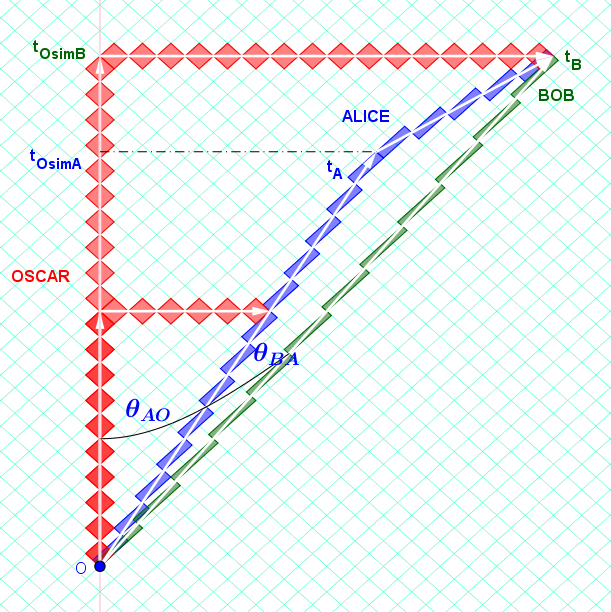Your first derived equation implies that $\gamma_u=\gamma_v\gamma_w$, which is not correct (time-dilation factors are not multiplicative). Instead, the correct relation [dropping the $c$'s] is
$$\gamma_u=\gamma_v\gamma_w(1+vw).$$
This is most easily seen using rapidities [Minkowski-angles] $\theta$, where $v=\tanh\theta$.
I will modify your notation for clarity.
$v=\tanh\theta_{AO}$ and $\gamma_v=\cosh\theta_{AO}$ (where $\theta_{AO}$ is the rapidity from $O$ to $A$).
$w=\tanh\theta_{BA}$ and $\gamma_w=\cosh\theta_{BA}$
$u=\tanh\theta_{BO}$ and $\gamma_u=\cosh\theta_{BO}$
Since rapidities add, we have $\theta_{BO}=\theta_{BA}+\theta_{AO}$.
Thus,
$\begin{align}\gamma_u=\cosh\theta_{BO}&=\cosh(\theta_{BA}+\theta_{AO})\\
&=\cosh\theta_{BA}\cosh\theta_{AO}+\sinh\theta_{BA}\sinh\theta_{AO}\\
&=\cosh\theta_{BA}\cosh\theta_{AO}(1+\tanh\theta_{BA}\tanh\theta_{AO})\\
&=\gamma_w\gamma_v(1+wv)\\
\end{align}$
So, your first derived equation is incorrect. To see why that is, it would be good to draw a spacetime diagram. I'll draw one using rotated graph paper so that we can visualize the ticks along the segments.

Your first time-dilation equation can be written as $t_O=t_A \gamma_v=t_A \cosh\theta_{AO}$,
which says that
the adjacent leg $t_O$ is equal to the hypotenuse $t_A$ times $\cosh\theta_{AO}$ in a Minkowski-right-triangle.
Furthermore, the event at $t_O$ along O's worldline is what he says is "simultaneous with the distant event at $t_A$ along Alice's worldline"... so maybe call it $t_{OsimA}$].
Similarly,
the adjacent leg $t_A$ is equal to the hypotenuse $t_B$ times $\cosh\theta_{BA}$, and
the adjacent leg $t_O$ is equal to the hypotenuse $t_B$ times $\cosh\theta_{BO}$.
But, from the diagram, if the first two are true, the last one can't be true since the event at $t_O$ on O's worldline can't be simultaneous with both $t_A$ on A's worldline and $t_B$ on B's worldline. Simultaneity isn't generally transitive.
So, you need to do some work to get the correct third time-dilation equation. The spacetime diagram might help.
By the way, since the rapidities add, we have
$\begin{align}u=\tanh\theta_{BO}&=\tanh(\theta_{BA}+\theta_{AO})\\
&=\frac{\tanh\theta_{BA}+\tanh\theta_{AO}}{1+\tanh\theta_{BA}\tanh\theta_{AO}}\\
&=\frac{w+v}{1+wv}\\
\end{align}$
which is the velocity-composition formula you seek.
In the diagram shown, $v=(3/5)$, $w=(5/13)$, and $u=(16/20)=(4/5)$.
so, the time-dilation factors are [adjacent/hypotenuse]:
$\gamma_v=(10/8)=(5/4)$, $\gamma_w=(13/12)$, and $\gamma_u=(20/12)=(5/3)$.
You can verify the velocity composition formula:
$\begin{align}u&=\frac{w+v}{1+wv}\\
\left(\frac{4}{5}\right)&=\frac{\left(\frac{5}{13}\right)+\left(\frac{3}{5}\right)}{1+\left(\frac{5}{13}\right)\left(\frac{3}{5}\right)}\\
\end{align}$
and the time-dilation factor relation:
$\begin{align}\gamma_u&=\gamma_w\gamma_v(1+wv)\\
\left(\frac{5}{3}\right)&=\left(\frac{13}{12}\right)\left(\frac{5}{4}\right)\left(1+\left(\frac{5}{13}\right)\left(\frac{3}{5}\right)\right)
\end{align}$
In addition, a multiplicative relation does hold for the doppler factors $k_v=\sqrt{\frac{1+v}{1-v}}$, which is equal to the exponential function of the rapidity:
$\begin{align}k_u=\exp\theta_{BO}&=\exp(\theta_{BA}+\theta_{AO})\\
&=\exp\theta_{BA}\exp\theta_{AO}\\
&=k_w k_v\\
\end{align}$
you can express this in terms of the velocities... do some algebra and get the velocity-composition formula. One develops this formula using a light ray (as shown) and relating the elapsed times from the common meeting event. (This is in the spirit of the Bondi k-calculus.)

In terms of the velocities in the diagram,
the doppler factors are [reception-leg/emission-leg]:
$k_v=(8/4)=2$, $k_w=(12/8)=(3/2)$, and $k_u=(12/4)=(3)$.
You can verify the Doppler-factor relation:
$\begin{align}k_u&=k_w k_v\\
(3)&=\left(\frac{3}{2}\right)(2)
\end{align}$


